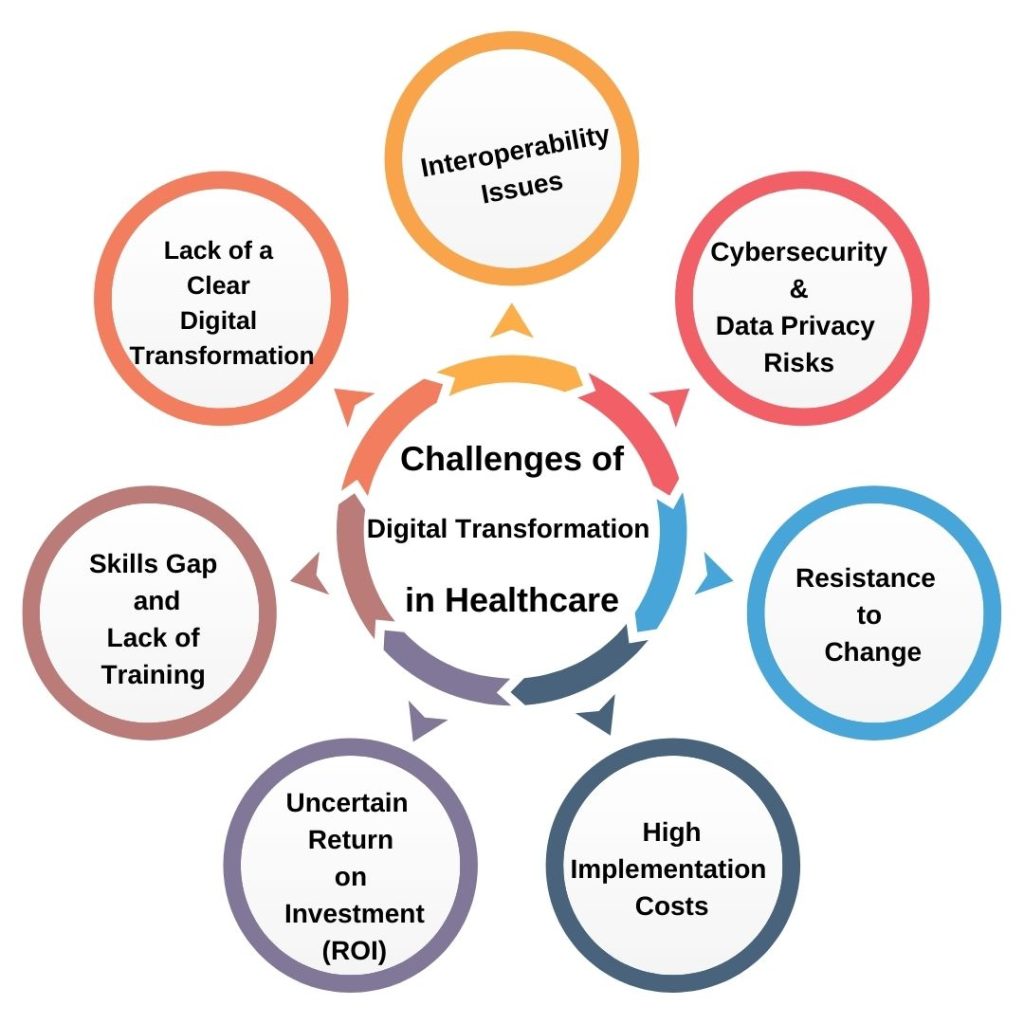Why does it seem like healthcare is always a step behind when it comes to digital transformation?
While industries like finance and retail have rapidly adopted new technologies, healthcare often moves at a frustratingly slow pace.
Despite breakthroughs in telemedicine, AI diagnostics, and electronic health records, real-world implementation remains inconsistent and complex.
In this article, we’ll explore the top 10 challenges of digital transformation in healthcare and understand why this adoptation is not as easy as it seems.
1. Interoperability Issues
Have you ever visited a hospital and had to repeat your medical history multiple times?
It’s frustrating, right?
This happens because different healthcare systems don’t always “talk” to each other. This problem is known as interoperability issues.
Hospitals, clinics, and pharmacies use different software to store patient records. Ideally, all this data should be in one place, making it easy for doctors to review patient history and create treatment plans.
But in reality, these systems often don’t connect well. If a patient’s past reports were done at another hospital, their current doctor might not have access to them. This can lead to delays in treatment and even medical errors.
Upgrading old systems takes time, money, and expertise. Privacy laws also make data sharing complicated. As data moves between systems, it becomes more vulnerable to hacking and misuse.
A survey by the American Medical Association (AMA) found that 75%of patients are concerned about protecting their personal health data.
Solving interoperability issues requires standardized data formats, better APIs, and industry-wide collaboration—something that’s been difficult to achieve at scale
2. Cybersecurity and Data Privacy Risks
Cybersecurity and data privacy are major concerns in healthcare because patient records contain sensitive information like names, addresses, medical histories, and payment details.
Hackers target hospitals since healthcare data is more valuable than credit card information, with records selling for up to $1,000 each.
Cyberattacks, especially ransomware, have increased by 128% in recent years, locking hospital systems and delaying urgent care. The main challenges include outdated systems, human errors, risks in data sharing, and a lack of cybersecurity experts.
To improve security, hospitals must follow SOC 2 compliance, which ensures that healthcare organizations handle patient data securely and protect it from breaches.
They should also use strong encryption, train staff to recognize cyber threats, update old systems, implement multi-factor authentication, and regularly back up data.
3. Resistance to Change
Change is hard, especially in healthcare. Many doctors and nurses have used the same methods for years and worry that new technology will make their jobs harder.
Some fear that learning digital systems will take too much time, while others don’t fully trust technology to be accurate and reliable.
Patients may also resist using digital tools due to privacy concerns or difficulty navigating new systems.
Hospitals worry about high costs, and staff fear that automation could replace jobs. To overcome resistance, healthcare organizations must provide proper training, show real benefits, and offer support.
When people see how technology saves time and improves care, they are more likely to accept it.
4. High Implementation Costs
Switching to digital healthcare is expensive. Hospitals need new software, updatedhardware, and strong security systems. On top of that, they must train staff, hire IT experts, and maintain the system.
According to estimates, a full Electronic Health Record (EHR) system can cost between $30million to $50 million for large hospitals. Even smaller clinics may need to spend hundreds of thousands of dollars.
For many healthcare providers, this price is too high. Budget constraints make it hard to invest in digital transformation, especially for smaller hospitals or rural clinics. Ongoing maintenance and upgrades add even more costs.
Governments and private organizations also offer grants and financial support to help with the transition. While the initial investment is high, the long-term benefits make digital transformation anecessary step for betterhealthcare.
5. Skills Gap and Lack of Training
Technology in healthcare is growing fast, but not everyone is ready for it. Many doctors, nurses, and hospital staff lack the technical skills to use new digital systems properly.
A 2022 survey found that 67% of healthcare workers struggle with digital tools, leading to frustration and mistakes.
Without proper training, even the best technology won’t be useful. Staff may enter incorrect data, delay patient care, or avoid using the system altogether. Some fear that learning new systems will take too much time, adding to their already busy schedules. Others worry that making mistakes could put patient safety at risk.
Hospitals need to invest in training to close this skills gap. Regular workshops, hands-on practice, and 24/7 tech support can help staff feel more confident.

6. Regulatory and Compliance Challenges
Healthcare follows strict rules to protect patient safety and privacy. Every new digital system must meet government regulations, which can be complex and time-consuming.
Laws like HIPAA (in the U.S.) and GDPR (in Europe) require hospitals to store and share patient data securely.
A 2023 report found that 80% of healthcare organizations struggle with compliance due to constantly changing regulations.
Failing to follow these rules can lead to huge fines, legal trouble, and loss of patient trust. In 2022, a major U.S. hospital was fined $875,000 for a data breach.
Many healthcare providers also face confusion because different countries and states have different laws. This makes it difficult to create a system that works everywhere.
To stay compliant, hospitals need expert legal guidance, strong cybersecurity, and regular audits.
7. Integration with Legacy Systems
Many hospitals still use old software and outdated systems. These legacy systems were built years ago and don’t always work well with new digital tools. This creates a big challenge when trying to upgrade technology.
Doctors and nurses need quick access to patient records, but if systems don’t communicateproperly, it can lead to delays, missing information, or even medical errors.
Upgrading is also expensive and time-consuming. Some hospitals can’t afford to replace their entire system, so they keep using outdated technology, even if it slows down care.
To fix this, healthcare providers need smart integration solutions that help old and new systems work together. Cloud-based platforms and interoperability standards can bridge the gap.
8. Lack of a Clear Digital Transformation Strategy
Many healthcare organizations want to go digital, but they don’t have a clear plan. Without a proper strategy, they struggle to choose the right technology, set goals, and train staff.
Some hospitals invest in new systems without fully understanding their needs. This leads to wasted money, unused technology, and frustrated staff.
Others start digital projects but fail to follow through, leaving systems half-integrated and difficult to use.
A strong digital transformation strategy should focus on clear goals, staff training, and step-by-step implementation.
Hospitals must involve both medical and IT teams to ensure that technology truly improves patient care.
Without a solid plan, digital transformation can cause more problems than it solves.
9. Lack of Accessibility and Digital Divide
Not everyone has equal access to digital healthcare. Many rural areas and low-income communities struggle with poor internet, outdated devices, or a lack of digital skills.
A 2022 report found that 40% of rural hospitals in the U.S. lack proper digital infrastructure, making telemedicine and online records difficult to use.
Elderly patients and those with disabilities also face challenges. Some struggle to use healthcare apps, while others can’t afford smartphones or computers.
Language barriers and low digital literacy make it even harder for some patients to access online health services.
To close this gap, healthcare providers must offer simple, user-friendly platforms and alternative options like phone consultations. Governments and organizations need to invest in better internet access, affordable technology, and digital literacy programs.
10. Uncertain Return on Investment (ROI)
Digital transformation in healthcare requires huge investments, but many hospitals worry about whether it will pay off.
A 2023 report found that 40% of healthcare leaders hesitate to invest in digital tools due to unclear ROI.
Some organizations fear that training staff, upgrading systems, and maintaining security will cost more than the savings they expect. Others struggle to measure success because improvements like better patient outcomes or smoother workflows are hard to calculate in dollars.
To reduce this uncertainty, hospitals should set clear goals, track key performance indicators (KPIs), and focus on long-term benefits.
While the upfront cost is high, a well-planned digital strategy can save money over time by reducing errors, improving efficiency, and enhancing patient trust.
Final Words
Healthcare’s digital transformation is full of promise—but also significant challenges. Interoperability problems slow down data sharing, while cybersecurity threats put patient privacy at risk. Many healthcare workers lack the technical training to use new systems effectively, and outdated infrastructure makes upgrades complex and costly. .Without a clear, well-executed strategy, digital initiatives risk falling short—wasting valuable resources and delivering uncertain outcomes



